人体解剖生理学Human Anatomy and Physiology汇总
- 格式:ppt
- 大小:1.17 MB
- 文档页数:42
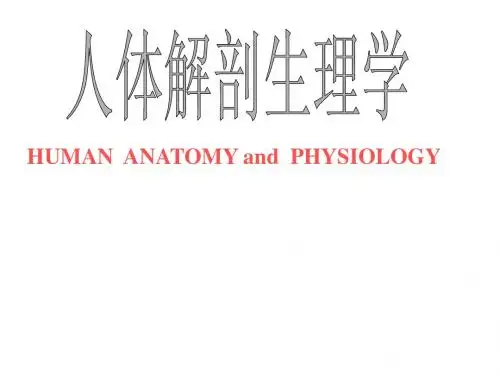
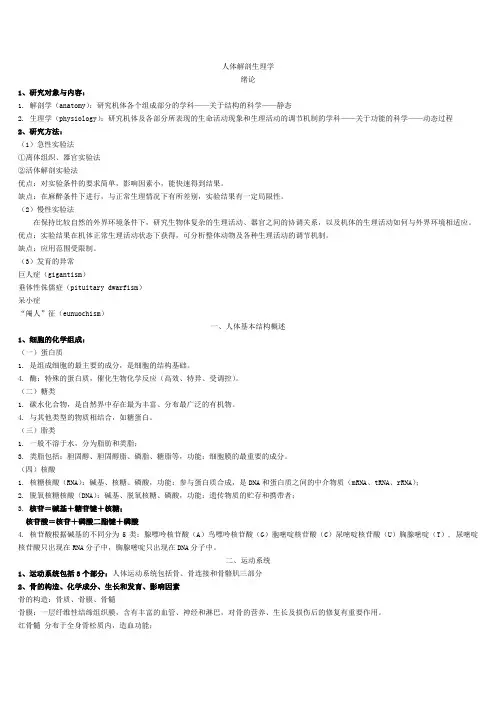
人体解剖生理学绪论1、研究对象与内容:1. 解剖学(anatomy):研究机体各个组成部分的学科——关于结构的科学——静态2. 生理学(physiology):研究机体及各部分所表现的生命活动现象和生理活动的调节机制的学科——关于功能的科学——动态过程2、研究方法:(1)急性实验法①离体组织、器官实验法②活体解剖实验法优点:对实验条件的要求简单,影响因素小,能快速得到结果。
缺点:在麻醉条件下进行,与正常生理情况下有所差别,实验结果有一定局限性。
(2)慢性实验法在保持比较自然的外界环境条件下,研究生物体复杂的生理活动、器官之间的协调关系,以及机体的生理活动如何与外界环境相适应。
优点:实验结果在机体正常生理活动状态下获得,可分析整体动物及各种生理活动的调节机制。
缺点:应用范围受限制。
(3)发育的异常巨人症(gigantism)垂体性侏儒症(pituitary dwarfism)呆小症“阉人”征(eunuochism)一、人体基本结构概述1、细胞的化学组成:(一)蛋白质1. 是组成细胞的最主要的成分,是细胞的结构基础。
4. 酶:特殊的蛋白质,催化生物化学反应(高效、特异、受调控)。
(二)糖类1. 碳水化合物,是自然界中存在最为丰富、分布最广泛的有机物。
4. 与其他类型的物质相结合,如糖蛋白。
(三)脂类1. 一般不溶于水,分为脂肪和类脂;3. 类脂包括:胆固醇、胆固醇脂、磷脂、糖脂等,功能:细胞膜的最重要的成分。
(四)核酸1. 核糖核酸(RNA):碱基、核糖、磷酸,功能:参与蛋白质合成,是DNA和蛋白质之间的中介物质(mRNA、tRNA、rRNA);2. 脱氧核糖核酸(DNA):碱基、脱氧核糖、磷酸,功能:遗传物质的贮存和携带者;3. 核苷=碱基+糖苷键+核糖;核苷酸=核苷+磷酸二酯键+磷酸4. 核苷酸根据碱基的不同分为5类:腺嘌呤核苷酸(A)鸟嘌呤核苷酸(G)胞嘧啶核苷酸(C)尿嘧啶核苷酸(U)胸腺嘧啶(T), 尿嘧啶核苷酸只出现在RNA分子中,胸腺嘧啶只出现在DNA分子中。

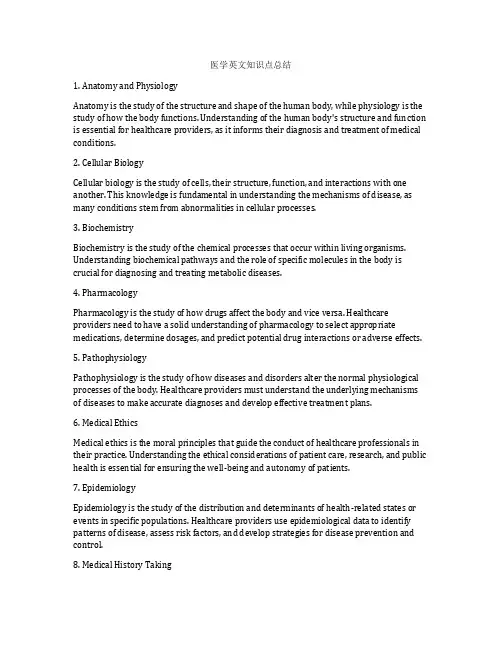
医学英文知识点总结1. Anatomy and PhysiologyAnatomy is the study of the structure and shape of the human body, while physiology is the study of how the body functions. Understanding of the human body's structure and function is essential for healthcare providers, as it informs their diagnosis and treatment of medical conditions.2. Cellular BiologyCellular biology is the study of cells, their structure, function, and interactions with one another. This knowledge is fundamental in understanding the mechanisms of disease, as many conditions stem from abnormalities in cellular processes.3. BiochemistryBiochemistry is the study of the chemical processes that occur within living organisms. Understanding biochemical pathways and the role of specific molecules in the body is crucial for diagnosing and treating metabolic diseases.4. PharmacologyPharmacology is the study of how drugs affect the body and vice versa. Healthcare providers need to have a solid understanding of pharmacology to select appropriate medications, determine dosages, and predict potential drug interactions or adverse effects.5. PathophysiologyPathophysiology is the study of how diseases and disorders alter the normal physiological processes of the body. Healthcare providers must understand the underlying mechanisms of diseases to make accurate diagnoses and develop effective treatment plans.6. Medical EthicsMedical ethics is the moral principles that guide the conduct of healthcare professionals in their practice. Understanding the ethical considerations of patient care, research, and public health is essential for ensuring the well-being and autonomy of patients.7. EpidemiologyEpidemiology is the study of the distribution and determinants of health-related states or events in specific populations. Healthcare providers use epidemiological data to identify patterns of disease, assess risk factors, and develop strategies for disease prevention and control.8. Medical History TakingTaking a thorough and accurate medical history is essential in diagnosing and treating patients. Healthcare providers must ask targeted questions to gather information about a patient's symptoms, medical history, family history, and social history.9. Physical ExaminationConducting a systematic and comprehensive physical examination is essential for assessing a patient's overall health. Healthcare providers must be proficient in techniques such as inspection, palpation, percussion, and auscultation to identify abnormalities and make accurate diagnoses.10. Diagnostic TestingInterpreting diagnostic tests such as blood work, imaging studies, and electrocardiograms is essential for diagnosing and monitoring medical conditions. Healthcare providers must understand the indications for specific tests, their limitations, and the interpretation of results.11. Clinical Decision MakingClinical decision making involves synthesizing patient information, medical knowledge, and available evidence to make informed choices about patient care. Healthcare providers must weigh the risks and benefits of treatment options and involve patients in shared decision making.12. Patient CommunicationEffective communication with patients is essential for building trust, conveying information, and involving patients in their care. Healthcare providers must use clear, empathetic, and culturally sensitive communication to ensure patient understanding and engagement.13. Patient EducationPatient education is crucial for empowering patients to manage their health and participate in treatment decisions. Healthcare providers must provide relevant information about medical conditions, treatment options, lifestyle modifications, and self-care strategies. 14. Preventive MedicinePreventive medicine aims to reduce the incidence and impact of disease through health promotion, disease prevention, and early detection. Healthcare providers must understand risk factors, screening guidelines, and immunization schedules to promote primary and secondary prevention.15. Interprofessional CollaborationInterprofessional collaboration involves working with other healthcare professionals to optimize patient care. Healthcare providers must effectively communicate, coordinate care, and respect each other's expertise to achieve positive patient outcomes.16. Patient SafetyPatient safety involves addressing the risks, errors, and harm in healthcare to prevent adverse events and promote a culture of safety. Healthcare providers must implement strategies to improve medication safety, prevent healthcare-associated infections, and reduce diagnostic errors.17. Quality ImprovementQuality improvement involves systematic efforts to enhance the effectiveness, efficiency, and safety of healthcare delivery. Healthcare providers must use data-driven approaches to identify and address opportunities for improvement in patient care.18. Global HealthGlobal health focuses on improving health and achieving equity in health for all people worldwide. Healthcare providers must understand the social, economic, and environmental determinants of health to address global health challenges such as infectious diseases, non-communicable diseases, and health disparities.19. Medical ResearchMedical research aims to advance knowledge in healthcare and improve patient outcomes. Healthcare providers must understand research methodology, scientific evidence, and ethical considerations to critically appraise research findings and apply them to practice.20. Healthcare PolicyHealthcare policy involves the development and implementation of regulations, laws, and programs to improve the delivery, quality, and cost-effectiveness of healthcare. Healthcare providers must understand healthcare policy to advocate for patients, promote health equity, and address healthcare disparities.In conclusion, a comprehensive understanding of medical knowledge points is essential for healthcare providers to provide high-quality, safe, and effective care to patients. Continual learning and application of these knowledge points are crucial for improving patient outcomes and advancing the field of medicine.。
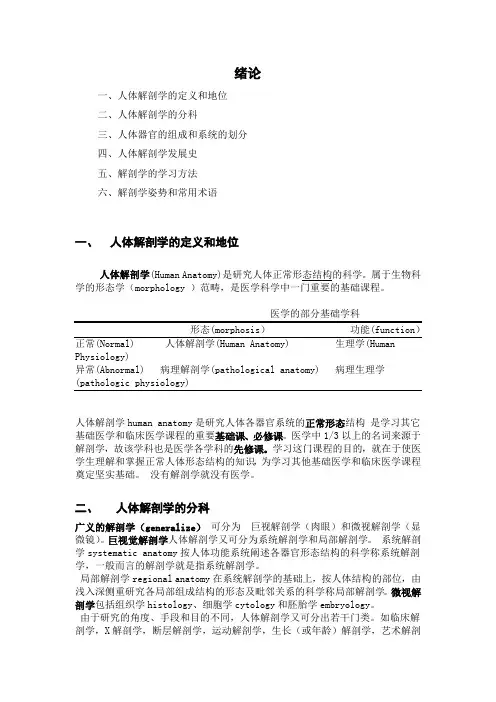
绪论一、人体解剖学的定义和地位二、人体解剖学的分科三、人体器官的组成和系统的划分四、人体解剖学发展史五、解剖学的学习方法六、解剖学姿势和常用术语一、人体解剖学的定义和地位人体解剖学(Human Anatomy)是研究人体正常形态结构的科学。
属于生物科学的形态学(morphology )范畴,是医学科学中一门重要的基础课程。
医学的部分基础学科形态(morphosis)功能(function)正常(Normal) 人体解剖学(Human Anatomy) 生理学(Human Physiology)异常(Abnormal) 病理解剖学(pathological anatomy) 病理生理学(pathologic physiology)人体解剖学human anatomy是研究人体各器官系统的正常形态结构是学习其它基础医学和临床医学课程的重要基础课、必修课。
医学中1/3以上的名词来源于解剖学,故该学科也是医学各学科的先修课。
学习这门课程的目的,就在于使医学生理解和掌握正常人体形态结构的知识,为学习其他基础医学和临床医学课程奠定坚实基础。
没有解剖学就没有医学。
二、人体解剖学的分科广义的解剖学(generalize)可分为巨视解剖学(肉眼)和微视解剖学(显微镜)。
巨视觉解剖学人体解剖学又可分为系统解剖学和局部解剖学。
系统解剖学systematic anatomy按人体功能系统阐述各器官形态结构的科学称系统解剖学,一般而言的解剖学就是指系统解剖学。
局部解剖学regional anatomy在系统解剖学的基础上,按人体结构的部位,由浅入深侧重研究各局部组成结构的形态及毗邻关系的科学称局部解剖学。
微视解剖学包括组织学histology、细胞学cytology和胚胎学embryology。
由于研究的角度、手段和目的不同,人体解剖学又可分出若干门类。
如临床解剖学,X解剖学,断层解剖学,运动解剖学,生长(或年龄)解剖学,艺术解剖学等。
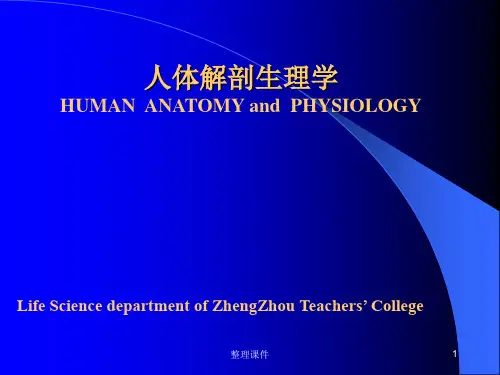

1. 人体解剖生理学的任务;P2生理学是研究活的有机体生命过程和功能的科学研究对象: 1生理学(Physiology)是以生命有机体的功能(function)为研究对象,即研究正常功能活动规律的科学2生理学就是以高等动物为为研究对象3解剖学(Anatomy)是研究生命有机体形态和构造的科学,隶属于生物科学的形态学范畴(广义的解剖学包括解剖学和组织学两部分)学习目的:1掌握生理学的基础理论、基本知识、基本技能2 各器官、系统的基本形态结构3 各器官系统的主要生理过程和机制4 生理学的基本实验方法学习方法:1形态结构和功能相关联、相统一,生命活动过程和机理的统一性2局部和整体、整体和环境对立统一3进化发展的观点,理论联系实际的观点4着重理解,掌握重点研究方法:研究水平:整体水平、系统和器官水平、细胞和分子水平研究方法:形态学→解剖学/组织学研究功能学→生理学研究:动物实验:急性实验(在体:暴露出某一部位(器官),研究其机能/离体:分离出所需器官、组织或细胞,置于适宜的人工环境,研究其机能)特点:能严格控制条件,排除其它非实验观察因素干扰,针对实验对象,进行直接细致的观测分析,但未必能反映正常情况下机体内的情况慢性实验:预先处理,近自然情况下观察研究特点:动物处于清醒状态,可作较长时间观察,获得数据接近自然状态。
但实验较复杂,影响因素多,因此必须严格控制人体观察研究5. 细胞内液、细胞外液的概念;P3细胞内液:人体内,存在于细胞内,其化学组成和含量直接影响细胞代谢与生理功能的体液。
约占2/3细胞内所有液体成分的总括,包括细胞质基质,核质,叶绿体等细胞器的基质以及液泡内的细胞液。
细胞外液:细胞直接接触的环境,细胞内液通过细胞膜与细胞外液相互交流包括血浆、组织液和淋巴等2.内环境的概念;P3内环境:细胞生活的环境,即细胞外液(占体液1/3)(细胞外液包括血浆1/4,组织液1/4(组织间隙液,淋巴液和脑脊液))内环境的稳态最终要反应在细胞内的自稳态,细胞内的稳定状态是细胞实现功能的基本条件。
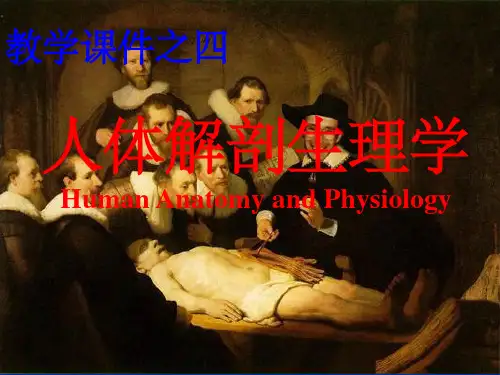
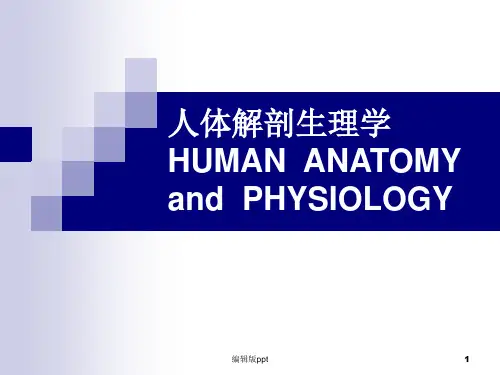
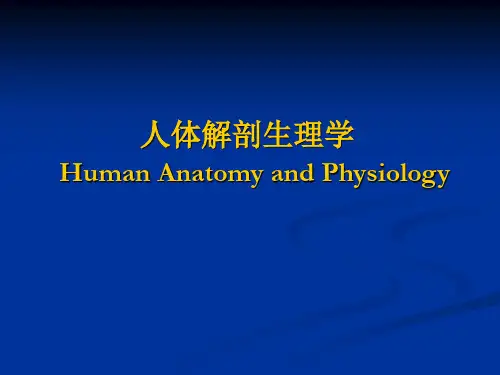
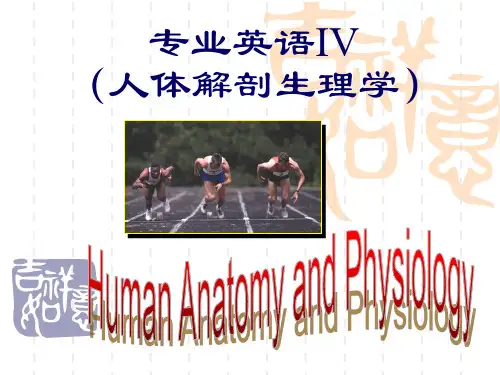
医学英文知识点总结大全1. Anatomy and Physiology- Anatomy is the study of the structure and organization of the human body. It involves learning about the different systems and organs and understanding how they function.- Physiology is the study of the functions and processes of the human body. It deals with how different organs and systems work together to maintain homeostasis.2. Cell Biology- Cells are the basic building blocks of life. They are the smallest units of living organisms and carry out all the necessary functions for life.- Cell biology involves studying the structure and function of cells, how they communicate with each other, and their role in the overall function of the body.3. Biochemistry- Biochemistry involves the study of the chemical processes and substances that occur within living organisms. This includes the study of metabolism, enzymes, and the chemical reactions that take place within the body.4. Pathology- Pathology is the study of diseases and the changes that occur within the body as a result of illness or injury. It involves understanding the causes and mechanisms of diseases and how they affect the body.5. Pharmacology- Pharmacology is the study of drugs and their effects on the body. It involves understanding how drugs work, the mechanisms of action, and their therapeutic uses.6. Microbiology- Microbiology is the study of microorganisms, including bacteria, viruses, fungi, and parasites. It involves understanding how these organisms can cause disease and how they can be controlled or treated.7. Immunology- Immunology is the study of the immune system and its response to pathogens. It involves understanding how the immune system works to protect the body from infections and how it can be manipulated to treat diseases.8. Genetics- Genetics is the study of heredity and the variation of inherited traits. It involves understanding how genes are passed from one generation to the next and how they can influence the development of diseases.9. Neurology- Neurology is the study of the nervous system, including the brain, spinal cord, and nerves. It involves understanding how the nervous system functions and how it can be affected by diseases or injuries.10. Cardiology- Cardiology is the study of the heart and the circulatory system. It involves understanding how the heart works, the causes of heart disease, and the treatment of cardiovascular disorders.11. Pulmonology- Pulmonology is the study of the respiratory system, including the lungs and airways. It involves understanding how the respiratory system functions, the causes of respiratory diseases, and their treatment.12. Gastroenterology- Gastroenterology is the study of the digestive system, including the stomach, intestines, and liver. It involves understanding how the digestive system works, the causes of gastrointestinal diseases, and their treatment.13. Endocrinology- Endocrinology is the study of the endocrine system, including hormones and their effects on the body. It involves understanding how hormones regulate various bodily functions, the causes of endocrine disorders, and their treatment.14. Nephrology- Nephrology is the study of the kidneys and the urinary system. It involves understanding how the kidneys function, the causes of kidney diseases, and their treatment.15. Oncology- Oncology is the study of cancer and the treatment of cancer. It involves understanding the causes of cancer, the different types of cancer, and their treatment options.16. Obstetrics and Gynecology- Obstetrics and gynecology is the study of the female reproductive system and pregnancy. It involves understanding the different stages of pregnancy, childbirth, and the management of gynecological disorders.17. Pediatrics- Pediatrics is the branch of medicine that deals with the health and medical care of infants, children, and adolescents. It involves understanding the developmental stages of children, common childhood illnesses, and their treatment.18. Geriatrics- Geriatrics is the branch of medicine that focuses on the health and care of elderly people. It involves understanding the aging process, the common health issues of older adults, and their management.19. Public Health- Public health is the study of the health of populations and communities. It involves understanding the epidemiology of diseases, the prevention of illnesses, and the promotion of health and well-being.20. Global Health- Global health is the study of health issues that transcend national borders, such as infectious diseases, maternal and child health, and non-communicable diseases. It involves understanding the health disparities between different regions and the development of strategies for improving global health.In conclusion, these are the key knowledge points in the field of medicine, encompassing a wide range of subjects that are essential for healthcare professionals to understand in order to provide effective care for patients.。